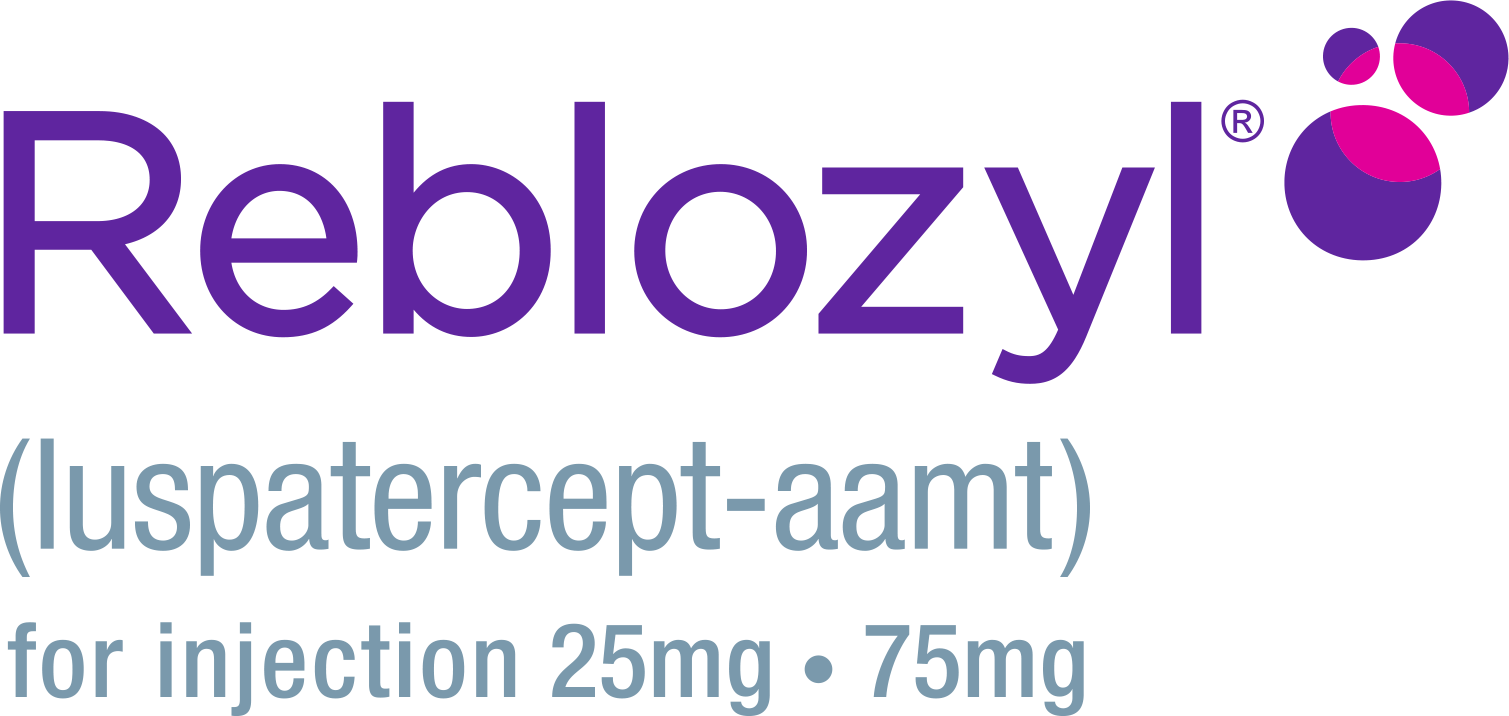Efficacy and safety: Hemoglobin IMPROVEMENT
The role of hemoglobin and how REBLOZYL impacts Hgb levels1-3
More REBLOZYL patients had a hemoglobin increase of ≥1.5 g/dL in the COMMANDS study2
Secondary endpoint:
Patients who achieved mean Hgb increase ≥1.5 g/dL in Weeks 1-242

Median baseline Hgb was 7.8 g/dL in COMMANDS study.2
REBLOZYL improved patients’ hemoglobin levels2,3
Secondary endpoint:
Mean Hgb change from baseline over 24 weeks (Weeks 1-24)2,3

Median baseline Hgb was 7.8 g/dL in COMMANDS study.2
Analysis limitations for mean Hgb change from baseline over 24 weeks4:
- These endpoints were not included in the statistical testing hierarchy, and no methods were employed to control the Type I error rate.
- These analyses should not be interpreted to determine treatment differences between arms because of lack of statistical hypothesis, testing, and the increased probability of a false-positive finding
Data cutoff date: August 2022.
A post hoc analysis of COMMANDS using patient-reported outcomes (PROs) across both study arms1
Hemoglobin and its relationship to quality of life1
Quality of Life Core 30 Questionnaire (QLQ-C30)1
Select chart view or table view to explore data

Domain measure from Coefficient (95% CI)* with Change from Baseline (>1.5 vs <1.5 g/dL)† against Absolute HgB (>10 vs <10 g/dL)†
Positive scores indicate improvement
- Global Health Status/Quality of Life 3.94 (1.87, 6.02) change from baseline versus 5.18 (2.95, 7.44) Absolute Hgb
- Physical Functioning 2.45 (0.62, 4.28) change from baseline versus 3.93 (1.91, 5.95) Absolute Hgb
Negative scores indicate improvement by reduction of symptoms
- Fatigue 3.70 (-6.13, -1.27) change from baseline versus -5.54 (-8.21, -2.87) Absolute Hgb
- Dyspnea -5.23 (-8.19, -2.28) versus -4.78 (-8.00, -1.56) Absolute Hgb
THE EORT QLG Core Questionnaire (EORTC-QLQ- C30) is a 30-item patient survey instrument designed to measure quality of life in all cancer patients.5
The change from baseline in hemoglobin level (1.5 g/dL) threshold and the absolute Hgb value (10 g/dL) threshold were based on recommended response criteria and target Hgb value.1

Analysis limitations1,5:
- HRQoL was assessed using the European Organisation for Research and Treatment of Cancer (EORTC) QLQ-C30 questionnaire–a validated tool used worldwide to assess QoL in patients with cancer. The statistical significance of QoL is not known. HRQoL was a post hoc analysis of the COMMANDS study and not a prespecified endpoint
*Coefficients can be interpreted as the change from baseline in PRO score per 1 g/dL increase in Hgb, or the difference in PRO score from baseline while a patient was experiencing a concurrent increase of ≥1.5 g/dL vs <1.5 g/dL from baseline or had a concurrent Hgb value of ≥10 g/dL vs <10 g/dL, depending on the model used.1
†PROs and Hgb levels collected in the Phase 3 COMMANDS randomized controlled trial were used to inform the analysis. Two PRO measures were used: the EORTC QLQ-C30 and the FACT-An, which were evaluated at prespecified timepoints. Hgb levels were assessed every 3 weeks or when deemed necessary by investigators. Seven anemia-related domain scores, including EORTC QLQ-C30 global health status/quality of life, physical functioning, fatigue, dyspnea, FACT-An fatigue subscale, anemia subscale, and total score were selected for this analysis. Three models were developed for each PRO domain varying the parameterization of Hgb level: (1) change from baseline (continuous), (2) change from baseline (≥1.5 vs <1.5 g/dL), (3) absolute value (≥10 vs <10 g/dL). This was a post-hoc analysis and not a prespecified endpoint of the COMMANDS study.1
Results from the QLQ-C30 in change from baseline in Hgb (continuous) included the following: Global Health Status/Quality of life: 2.43 (1.54, 3.31); Physical Functioning: 2.30 (1.49, 3.10); Fatigue: -3.20 (-4.24, -2.16); Dyspnea: -3.10 (-4.37, -1.83).1
Results from the FACT-An Fatigue Subscale include: 1.21 (0.97, 1.45) for change from baseline in Hgb (continuous); 1.42 (0.92, 1.91) for change from baseline in Hgb (≥1.5 vs <1.5 g/dL); and 1.29 (0.75, 1.83) for absolute Hgb (≥10 vs <10 g/dL). On the Anemia Subscale, results include: 1.54 (1.23, 1.84) for change from baseline in Hgb (continuous); 1.76 (1.13, 2.38) for change from baseline in Hgb (≥1.5 vs <1.5 g/dL); and 1.64 (0.96, 2.33) for absolute Hgb (≥10 vs <10 g/dL). For Total Score, results include: 2.66 (2.09, 3.23) for change from baseline in Hgb (continuous); 3.04 (1.88, 4.20) for change from baseline in Hgb (≥1.5 vs <1.5 g/dL); and 2.99 (1.72, 4.27) for absolute Hgb (≥10 vs <10 g/dL).1
CI=confidence interval; EHA=European Hematology Association; Hgb=hemoglobin; HRQoL=health-related quality of life; IPSS-R=Revised International Prognostic Scoring System; MDS=myelodysplastic syndromes; QLG=Quality of Life Group; QoL=quality of life; RS=ring sideroblast; SD=standard deviation; sEPO=serum erythropoietin.
References: 1. Oliva E, Yucel A, Lord-Bessen J, et al. Relationship between haemoglobin and quality of life in transfusion-dependent patients with lower-risk myelodysplastic syndrome receiving luspatercept or epoetin alfa. Presented at: European Hematology Association (EHA) Hybrid Congress. June 13-16, 2024. Madrid, Spain. Abstract P774. Abstract available at EHA library. 2. REBLOZYL [US Prescribing Information]. Summit, NJ: Celgene Corporation; 2024. 3. Platzbecker U, Della Porta MG, Santini V, et el. Efficacy and safety of luspatercept versus epoetin alfa in erythropoiesis-stimulating agent-naive, transfusion-dependent, lower-risk myelodysplastic syndromes (COMMANDS): interim analysis of a phase 3, open-label, randomised controlled trial (supplementary appendix). Lancet. 2023; published online June 10, 2023. https://doi.org/10.1016/S0140-6736(23)00874-7 4. Data on file. BMS-REF-ACE-536-0009. Princeton, NJ: Bristol-Myers Squibb Company; 2023. 5. European Organisation for Research and Treatment of Cancer: Quality of Life. Questionnaires. Accessed August 15, 2024. https://qol.eortc.org/questionnaires/

